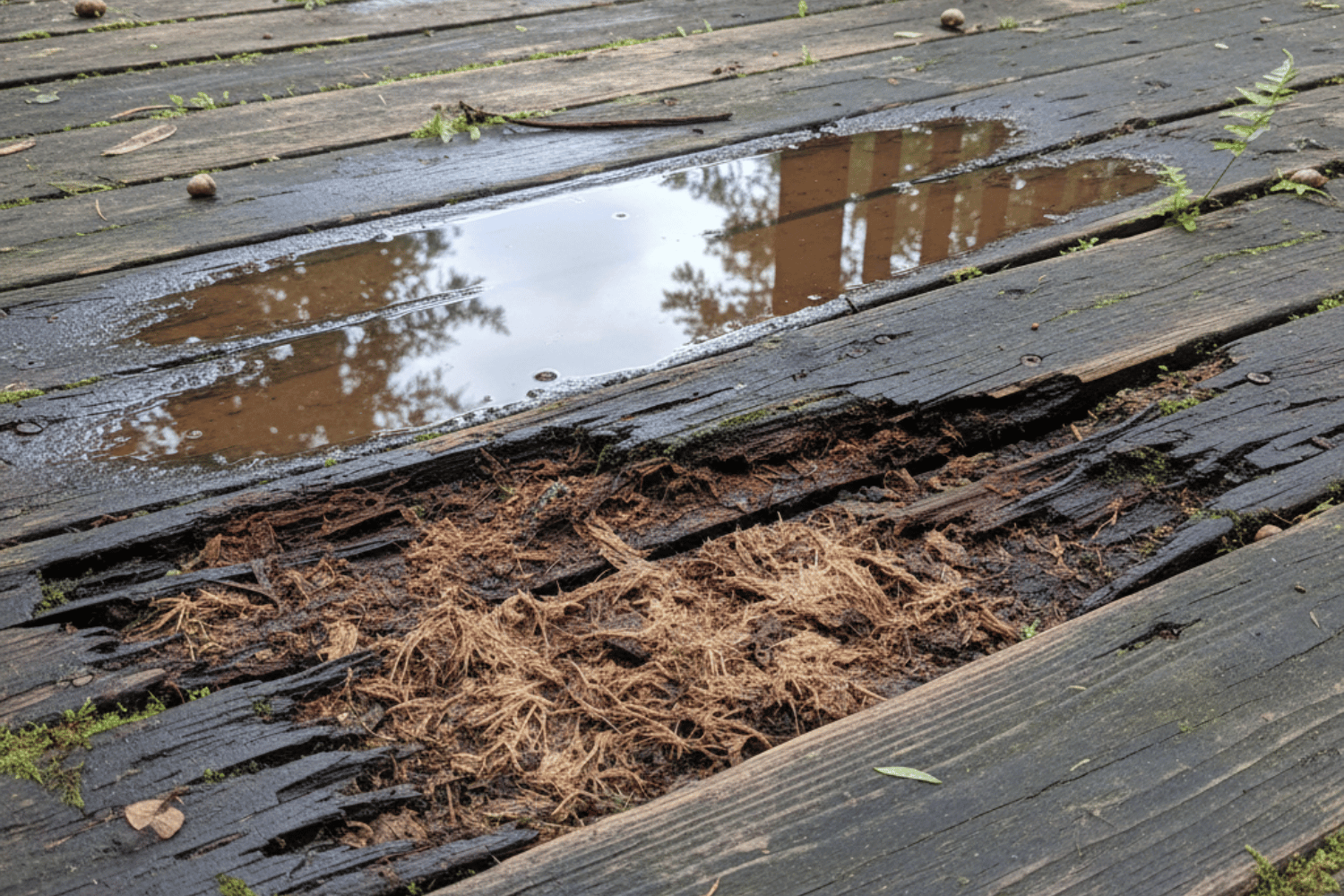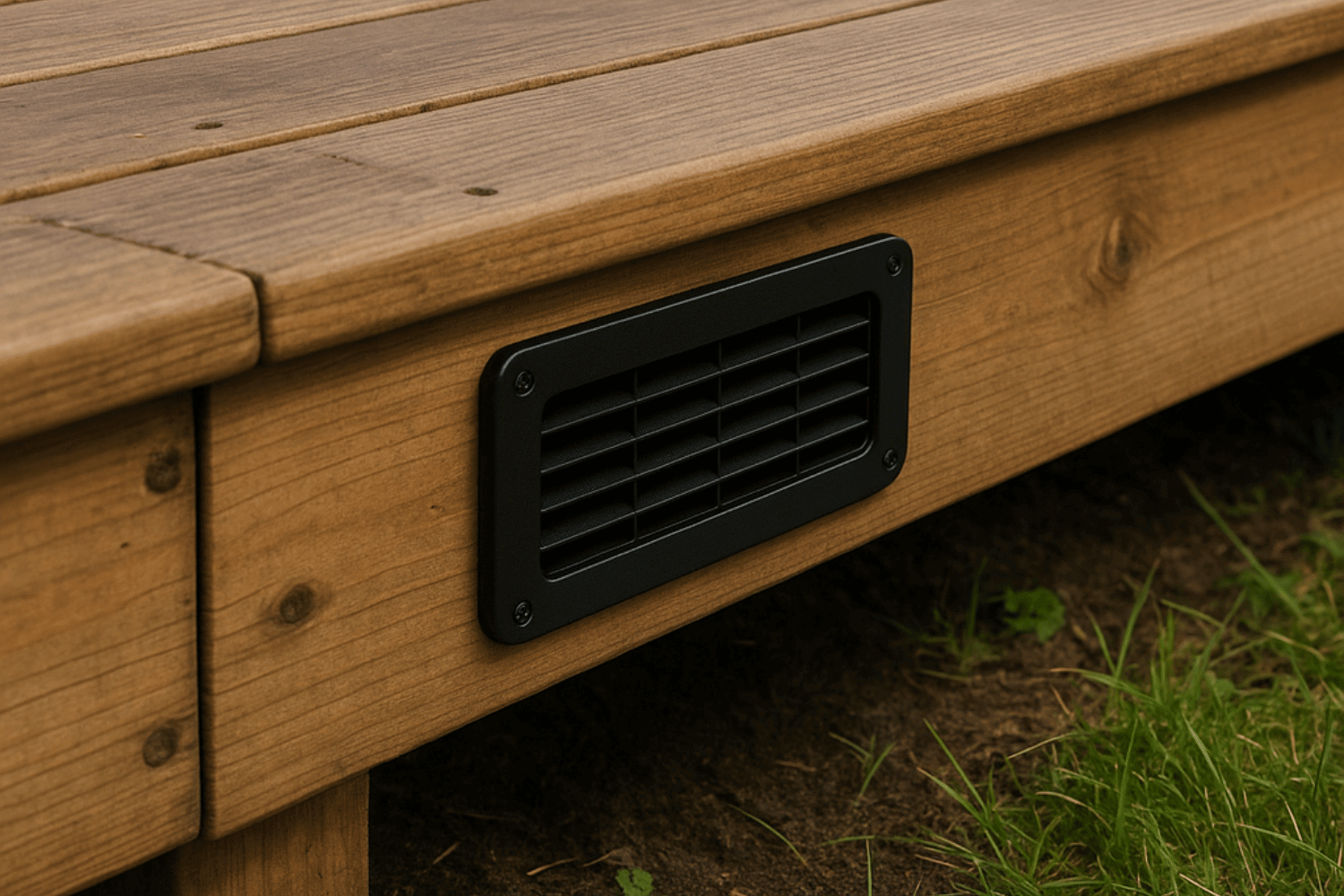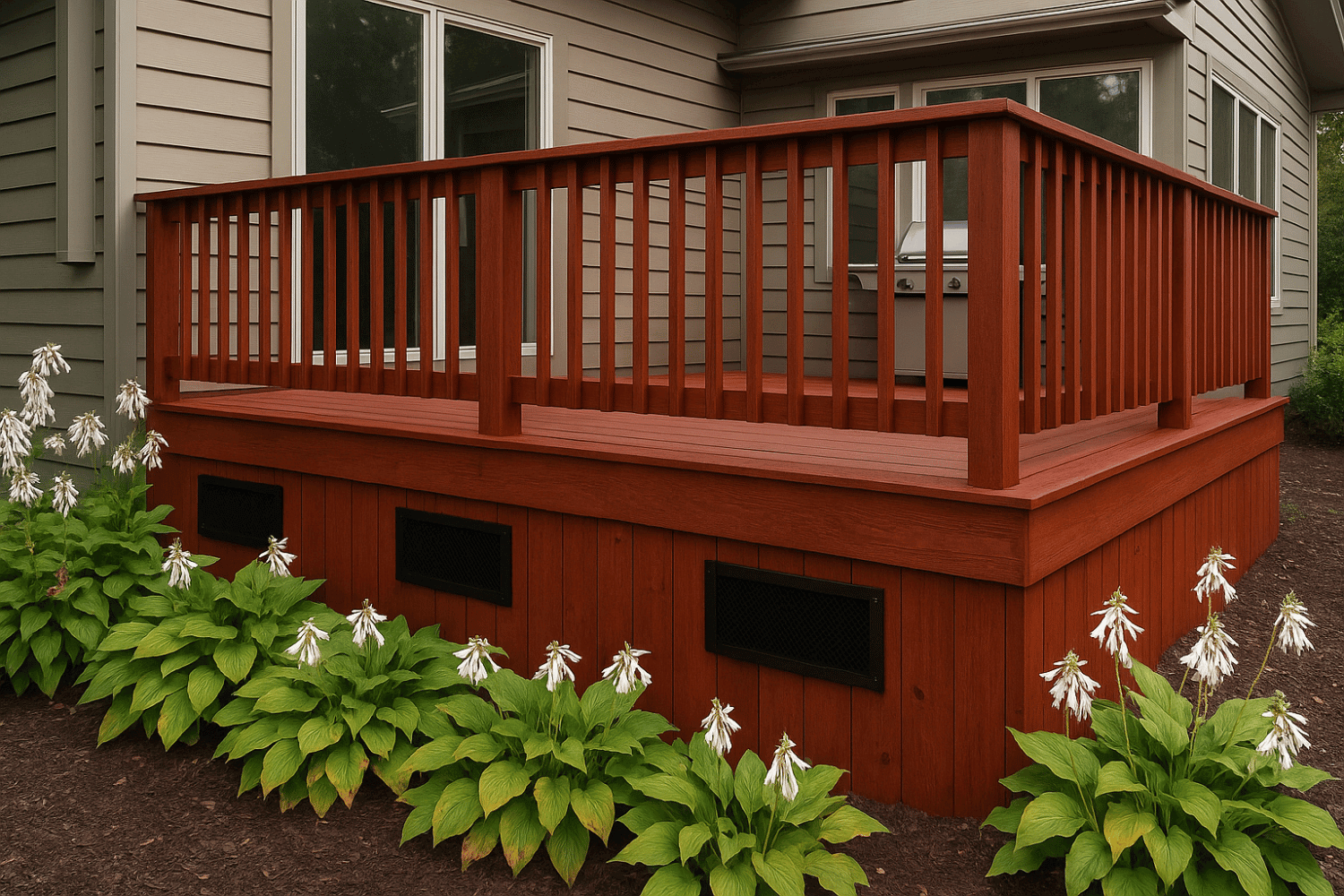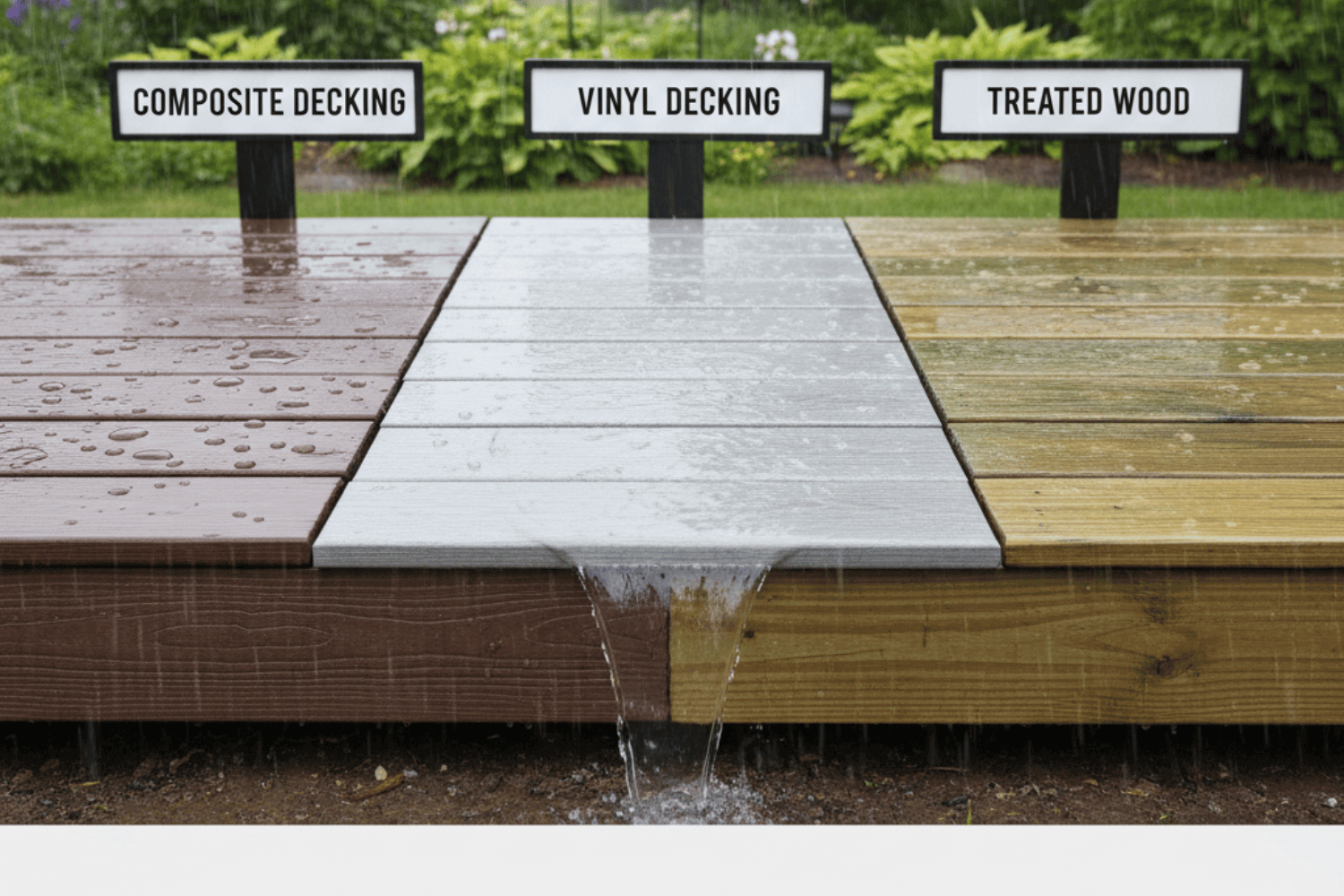Top Tips for Venting the Underside: Avoiding Moisture Rot in Your Deck
Moisture rot can silently destroy your deck from underneath. Proper venting the underside, avoiding moisture rot, is crucial to prevent this. In this article, you’ll find practical methods to keep your deck dry and rot-free.
Key Takeaways
- Understanding and addressing moisture rot early is essential to maintaining a healthy and beautiful deck.
- Proper ventilation is crucial for preventing moisture buildup, ensuring longevity, and keeping wooden decks in excellent condition.
- Choosing moisture-resistant materials and implementing regular maintenance can significantly extend the life and safety of your deck.
Understanding Moisture Rot in Decks
Moisture rot is a silent intruder that can wreak havoc on wood decks. Caused by fungal growth in wet conditions, moisture rot particularly targets untreated wood, leading to significant damage if left unchecked. The first step in combating this menace is understanding its nature and early signs.
Immediate action is crucial upon discovering moisture rot to prevent it from spreading to other areas of the deck. A small patch of rot can quickly escalate, compromising the entire structure. Regular inspections can help catch these small issues early, allowing for minor repairs rather than full-scale replacements.
Protective coatings like deck stain and treatments are invaluable in the fight against moisture rot. These coatings seal out water, providing a protective barrier that helps keep your deck in pristine condition. Proactive measures can significantly extend the life of your deck and maintain its beauty for years to come.
Importance of Proper Ventilation
Proper ventilation is the unsung hero of deck maintenance. Preventing moisture buildup is crucial, as it can lead to structural damage and costly repairs. Without adequate airflow, moisture can accumulate, creating a perfect environment for mold and rot to thrive.
Effective deck ventilation protects against weather damage and decay, ensuring the long-term structural integrity of your deck. Proper ventilation not only prevents rot but also eliminates musty smells and bad odors associated with damp wood and mold growth, which can smell bad.
Adequate airflow significantly prolongs your deck’s lifespan. Ventilation minimizes moisture retention, which is crucial for keeping your worn out decks in top shape. Ventilation should be a top priority, whether dealing with an old deck or planning a new installation.
Benefits of Airflow Underneath Your Deck
Good airflow beneath a deck is more than a maintenance tip; it’s a game-changer. Effective airflow reduces humidity levels, which is crucial in preventing the growth of mold and wood rot. Imagine giving your wooden deck a breath of fresh air every day – that’s the power of proper ventilation.
For those with composite decking or composite decks, airflow is equally important. It helps to keep the underside of the deck dry, significantly reducing the risk of mold and wood decay. Even in the rainy season, proper airflow ensures that moisture dries out quickly, protecting your deck boards from premature wear and tear.
Implementing natural airflow methods, like using vented skirting or lattice panels, can significantly enhance ventilation. These strategies not only promote airflow but also add aesthetic value to your outdoor space. For more enclosed decks, mechanical ventilation systems such as powered fans can be a lifesaver.
Common Ventilation Techniques
Achieving proper ventilation involves a few tried-and-true techniques. One of the simplest methods is creating gaps between deck boards. These gaps facilitate natural airflow, helping to keep the space beneath your deck dry.
Using vented skirting or lattice panels is another effective technique. These allow air to flow freely underneath the deck, preventing moisture buildup and promoting a healthier deck environment. It’s a small change that can make a big difference in maintaining the health of your deck.
Proper deck design plays a crucial role in ventilation. Ensuring adequate clearance from the ground and considering airflow during the initial new deck installation can prevent many moisture-related issues down the line. Integrating these techniques ensures your deck remains structurally sound for years to come.
Best Practices for Venting the Underside of Your Deck
Best practices for venting the underside of your deck prevent moisture-related issues. A minimum of 24 inches of unobstructed airspace beneath a deck helps reduce moisture accumulation. This simple step can dramatically extend the life of your wooden deck.
Mechanical ventilation options, such as exhaust fans, are highly effective for decks where natural airflow is insufficient. Additionally, installing drainage systems can help manage water pooling under the deck, further safeguarding against rot and mold.
Installing Vents and Fans
Strategically placing vents and fans can significantly enhance airflow under your deck. Placing vents at both low and high points of the deck optimizes airflow and prevents moisture accumulation. It’s a simple yet effective way to keep your deck dry and safe.
For decks with enclosed spaces or low clearance, mechanical options like vent fans are crucial. These fans help circulate air, especially in areas where natural airflow is inadequate. Regular inspections and cleaning of vents maintain their efficiency and prevent moisture buildup.
Combining natural and mechanical ventilation methods provides a comprehensive solution for maintaining proper ventilation. These steps ensure your deck remains a safe and enjoyable space for years to come.
Choosing the Right Skirting
Choosing the right deck skirting improves airflow and enhances the visual appeal of your board deck. Opting for skirting materials that allow ventilation, such as vented panels or lattice, can significantly improve airflow and reduce moisture retention.
Composite skirting materials are particularly favored for their durability and low maintenance. These materials not only look great but also help in preventing moisture issues, making them a smart choice for any deck.
Regular Maintenance Tips
Regular maintenance is crucial for ensuring proper ventilation and preventing moisture-related issues. Routine inspections can help identify any blockages in ventilation systems, allowing for timely repairs. Clearing debris from joists bays and beams maintains airflow and prevents moisture buildup.
Seasonal debris removal and maintenance of ventilation openings can prevent mold and structural damage to the exterior. Staying on top of these small tasks helps avoid costly repairs and extends the life of your Duluth deck.
Regular maintenance not only keeps your deck safe but also enhances its longevity through refinishing. It’s a small investment of time that pays off in the long run, ensuring your deck remains a beautiful and functional part of your home.
Materials That Resist Moisture Rot
Choosing the right materials can make a significant difference in preventing moisture rot. Composite decking, for instance, is engineered to withstand moisture and is less susceptible to rot compared to traditional wood. Modern composite materials often include additives that further enhance moisture resistance and longevity.
Vinyl decking is another excellent option, offering full waterproofing and high resistance to moisture damage. These materials do not require painting or staining, which helps maintain their moisture resistance over time.
Treated wood is also a viable choice, as it is chemically altered to resist decay and moisture. By investing in high-quality materials, you can ensure your deck remains structurally sound and beautiful, even in the harshest weather conditions.
DIY vs. Professional Help
Deciding between a DIY approach and hiring professional help depends on several factors. DIY deck replacement can save money, allowing homeowners to invest more in materials. It also offers the opportunity to personalize the design and materials to suit individual preferences.
However, lack of experience in deck construction can lead to safety hazards and costly repairs. Complex deck designs often require professional deck builders to avoid common construction errors. Professionals also ensure adherence to local building codes, minimizing legal risks.
Professional contractors can complete the job more quickly, reducing disruption for residential homeowners in their house. Their cost effective business services often come with warranties, providing an extra layer of security for repair.
Whether you choose to go DIY or hire a professional, consulting with experts can provide valuable insights to help you make the best detail decision for your project.
Summary
Ventilating the underside of your deck is not just an option; it’s a necessity for preventing moisture rot and extending the life of your deck. Proper ventilation prevents moisture buildup, which can lead to structural damage and costly repairs. By understanding the causes of moisture rot and implementing effective ventilation techniques, you can keep your deck in top shape.
Choosing the right materials, such as composite or vinyl, can also help prevent moisture issues. Whether you opt for a DIY approach or hire professional help, ensuring proper ventilation and using high-quality materials are key to maintaining a beautiful and safe deck.
Take action now to protect your deck from moisture rot. With the right knowledge and proactive measures, you can enjoy your outdoor space for years to come.
Frequently Asked Questions
What causes moisture rot in decks?
Moisture rot in decks occurs primarily due to fungal growth thriving in damp environments, especially in untreated wood. To protect your deck, consider using treated wood or sealing it to keep moisture at bay.
Why is proper ventilation important for my deck?
Proper ventilation is essential for your deck as it prevents moisture buildup, protecting against structural damage and costly repairs. Ensuring good airflow lets you enjoy your outdoor space with peace of mind!
What are some common ventilation techniques for decks?
Creating gaps between deck boards and incorporating vented skirting or lattice panels are effective ventilation techniques that promote airflow and keep your deck in great shape!
What materials are best for preventing moisture rot in decks?
Composite decking and vinyl are the best materials for preventing moisture rot in decks, as they are specifically designed to resist moisture and decay. Choosing these options will help ensure your deck remains beautiful and durable for years to come.
Should I attempt deck maintenance myself or hire a professional?
Hiring a professional for deck maintenance is often the best choice, as it ensures compliance with building codes and can save you from expensive errors. Enjoy peace of mind and a beautifully maintained deck by choosing expert help!






